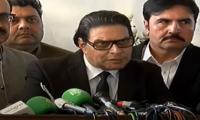Pakistan People’s Party Co-chairman Asif Ali Zardari was advised by some senior party leaders in Dubai to distance himself from the party and fully empower Chairman Bilawal Bhutto, which they considered the last hope for the party’s survival beyond Sindh. He listened to them with patience as he is known for this quality, but it appears he has delayed the announcement till the present confrontation with the establishment is over.
Bilawal, who is now learning Urdu so that he could speak with fluency, has told his party colleagues not to speak with him in English. It shows Bilawal has now made up his mind for running the party as well as Sindh government affairs.
His speech today would be of significance as there is every likelihood that his main target would be PML-N and Prime Minister Nawaz Sharif. Whether he will take a line over the row with the center on “ranger’s powers” different from his father would be interesting to watch.
Some party leaders believe the best option for party’s recovery depend on how much power delegated to Bilawal and more importantly what program it can give to the people in order to fill the vacuum between the PML-N and PTI.
Zardari’s statement on the eve of the birth anniversary of Quaid-e-Azam was more of political nature when he lashed out at the federal government for violating the constitution, in clear reference to the recent differences between Sindh and Center over the powers of the rangers.
Irrespective of the outcome of the issue, it showed that Zardari is neither in a mood to quit politics or distance himself. He has been advised to pick the position between Rahbar or Patron-in-chief, and in both the cases Bilawal would be fully empowered.
This latest position also shows that Zardari is also in mood to take confrontation, even if limited, with PML-N and Prime Minister Nawaz Sharif. However, both Zardari and Sindh government also know that the issue of the unconditional extension of powers to rangers has little to do with the federal government.
Zardari knows that the main ownership of the “Karachi operation,” and Zarb-e-Azb, National Action Plan, is with the army and the army chief, General Raheel Sharif, time and again said in clear words that, “no hindrance” would be acceptable.
So, it is very unlikely that the prime minister, during his visit to Karachi on Monday, would be able to address grievances of Sindh government as far as powers to rangers is concerned. The maximum he can offer is financial assistance.
Zardari and Nawaz has old “love and hate” relations from the day the PPP Co-chairman ditched PML-N leader over the issue of restoration of deposed judges in 2008. Zardari has taken over the party within three days after assassination of his spouse, Benazir Bhutto, who was killed in a suicide attack in Liaquat Bagh, Rawalpindi on December 27.
We are still in search of the assassin and conspiracy and Zardari’s biggest failure in the last eight years, five as president of Pakistan, to unearth the real conspiracy and get the assassin punished.
But the biggest casualty in the process was the party itself which despite having won elections in 2008 and completing its five years, is constantly on decline. The party is far from where Benazir left it. She led the party after her father Zulfikar Ali Bhutto was hanged.
The question is why Asif Zardari and now Bilawal Bhutto Zardari are finding it difficult to regain the lost popularity? Is this an end to the PPP beyond Sindh or can it bounce back? PPP vote bank is constantly on decline, both from the electable point of view as well as in percentage of votes.
Now, the party leaders from the Punjab, are looking forward to Bilawal’s much awaited visit to the most important constituency, which once was PPP’s strongest base. Bilawal is quite unlucky in many ways, unlike his mother who too went through difficult period. In the last few years, even his own father time and again made him “controversial.” The most surprising was Zardari’s reaction after Bilawal’s famous speech opposite Mazar-e-Quaid. Again, while addressing party leaders Zardari described him as “immature.”
All this did not go well in image building of PPP chairman. When his mother Benazir took over party leadership from her mother Begum Nusrat Bhutto and one by sideline her uncles except a few, situation was far more different than, today.
Benazir was a different leader and had the courage and character to challenge the establishment in her own style. She came back to Pakistan, refusing the advice as well as alleged threat to her life.
Minutes before assassination, she made a fiery speech, the last before 2007 election campaign but she did not know it turned out to her last speech. She was confident of her victory as she told her colleagues while leaving the venue. She made a last telephone call to Nawaz Sharif, after hearing an attack on her procession but could not speak. What happened afterwards is now a matter of history but country lost a dynamic and powerful leader.
PPP’s most difficult journey began after her funeral from Garhi Kuda Bux, from which the party has not recovered yet. Instead of late Makhdoom Amin Fahim, senior vice-chairman, the Central Executive Committee meeting was presided by Asif Zardari. Now his position on that day was that of the spouse of BB. In fact, he never had an official position in the party.
Zardari, who was in Dubai when BB was assassinated and rushed back after the incident surprised everyone when he placed a “BB’s Will” before the CEC, in which she had asked him to look after the party in case anything happened to her till the time Bilawal grows up.
BB, during her lifetime, had never disclosed about her successor or any “political will.” The party senior leaders did not question the “will” and accepted Zardari as co-chairman. Late Amin Fahim, who was initially named future PM, at the same press conference but minutes later dropped his name.
It was the beginning of Zardari’s political career as PPP leader, though previously he had served as minister and adviser. He did not ask for postponement of elections. Although PPP emerged as single largest party in 2008 elections it lost in Rawalpindi, where BB was killed.
PPP could take the credit that for the first time it got its president, which Zardari himself got elected, prime minister, speaker NA and chairman Senate, but at the same his move to “ditch” Nawaz Sharif and not to restore depose judges including former chief justice Iftikhar Chaudhry.
Zardari missed a great opportunity of running smooth government by ensuring implementation on Charter of Democracy, signed by Benazir Bhutto and Nawaz Sharif. His second blunder was his refusal to restore deposed judges, and unnecessarily converted anti-Musharraf lawyers movement towards his government. In the end, he restored the judges but under pressure and made Sharif stronger.
Though Zardari complete his tenure it was Sharif who succeeded, both as opposition leader in the center and head of the ruling party in Punjab. By taking confrontation with deposed judges, Zardari also faced “judicial problems,” and saw exit of PM Yusuf Raza Gilani on contempt charges.
Thirdly, it was Zardari’s policies, which on one hand gave edge to Sharif and on the other hand enabled Pakistan Tehreek-e-Insaf (PTI) to emerge as third force. Thus, in 2013 elections PTI replaced the PPP as the better option and now challenging the PML-N for the next elections. PPP ruined in the elections except in Sindh.
Now, Zardari is making another mistake by putting a much weaker PPP to take “head on” with the establishment and that too at a time when Bilawal is preparing for the revival or giving new birth to the party in Punjab.
It is high time that the PPP leader review the last eight years, and the causes for the party’s downfall and constant failure to an extent that party even finding difficulties in getting candidates. It was the same PPP, which led the movements against dictators and got elected record four times and survived all conspiracies. But this time the problem is from within and from the top. The solution also lies at the top.
Reports indicate that they tried to breach one of gates, harassed staff, and even scaled walls of premises
Nasir praised role of Interior Minister Syed Mohsin Naqvi, who controlled situation with tolerance
A fierce exchange of fire ensued, but culprits managed to escape under cover of darkness
Police said booked leaders and BYC workers gathered at main Turbat Chowk
Mobile internet outages became common fixtures during protests by PTI since Imran was ousted in 2022
Bokhari emphasised that cases have been registered against "Fasadis", and no one will be spared







